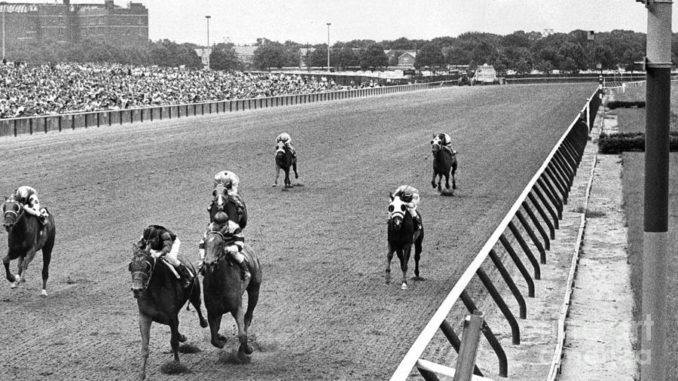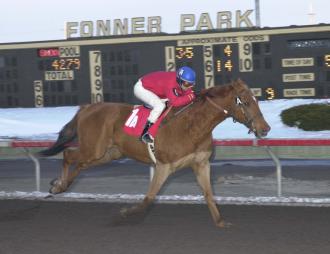
If Justify’s sweep of the Triple Crown magnifies anything, it’s that most of the virtually unrepeatable achievements ever attained by Thoroughbreds within living memory are generally the result not only of the innate talent of the horses involved but often the underlying philosophies of the owners, trainers, and breeders that made the feats possible at all.
Where does Justify’s accomplishment rank among achievements in the U.S. by Thoroughbreds in the post-World War II era widely considered unrepeatable? Here’s one man’s opinion.
10. All Along
They say money makes the mare go. That was certainly the case in the fall of 1983 when, after pulling off a 17-1 upset of the Prix de l’Arc de Triomphe (G1) (a race normally used as the culmination to a racing season), All Along continued a blitz of the Western racing world. Enticed by a $1 million bonus in those pre-Breeders’ Cup days, the French filly turned in dominating victories in the Canadian International (G1) at Woodbine, Turf Classic (G1) at Aqueduct, and Washington D.C. International (G1) at Laurel. Not only did she earn the bonus winning those three, but also swung majority support in her direction for Horse of the Year honors.
As is the case with most on this list, the aggressiveness displayed by her connections has become a receding memory. The specific races themselves now overlap each other or, in the case of the International, are long defunct. Transatlantic success at the top level is still relatively routine, but not four times in a mere six weeks.
9. Native Diver
Geldings obviously have an inside edge in attaining most of these feats. A swift California-bred star of the 1960s, Native Diver’s presumptive modern record of 34 career stakes victories has been unequaled or threatened in the subsequent half-century.
While the list lacks the breadth and geographic diversity of Round Table’s and Kelso’s 31 stakes each, a healthy splattering of major events in Southern California is interspersed with the relatively minor Northern California features Native Diver won. That includes three consecutive editions of the 1 1/4-mile Hollywood Gold Cup.
“The Diver” competed only once in state-bred company (and lost), but it would seem only a provincial star with similar longevity could, by keeping within the restricted ranks, make a run at this mark.
8. Justify
Sweeping the Triple Crown is not unique, but to do so with no two-year-old foundation and a mere 112 days after making your debut is something most long-time observers would have considered inconceivable up until a month ago. As this is unlikely to become a trendy preparation for the classics, the odds on its replication in the near future are similarly long.
7. Rachel Alexandra
There had been a pair of three-year-old fillies voted Horse of the Year in the 1940s, but neither had gone undefeated during their campaigns nor had they completed the troika of a classic win, a demolition of the season’s leading three-year-old colt, and a victory against older males. Rachel Alexandra did all three — in the Preakness (G1), Haskell Invitational (G1) over Summer Bird, and Woodward (G1) — in a season for the ages from a three-year-old filly.
6. Genuine Risk
Although benefiting from facing a crop of that did not include any Hall of Fame-worthy colts or geldings as in the three previous years, Genuine Risk’s achievement of running first or second in all three Triple Crown races in 1980 is a singular achievement for a three-year-old filly, one that would have been beyond the scope of virtually every other divisional champion before or since. With recent changes to the Kentucky Derby qualifying process, its potential duplication appears more remote than ever.
5. Buckpasser (Tom Fool–Busanda)
The Suburban Handicap doesn’t quite carry the cachet that it used to, but for more than a century it stood as one of the premier races for older horses in the country. It was also the scene of one of racing’s unique occurrences.
Multiple generations of colts and geldings or fillies and mares can claim to have won the same race, but the Suburban has the distinction of being won by a father-mother-son combination. The mare Busanda captured the 1951 Suburban, a race won two years later by Tom Fool. Their union produced Buckpasser, who captured the Suburban in 1967.
With fillies and mares a rarity in open stakes, much less those of Grade 1 quality, this feat seems assured of standing alone for some time to come.

4. Citation
Acclaimed then (and still by some later on) as the century’s best following a 19-for-20 season in 1948, Citation’s lasting claim to fame perhaps should be the accumulation of 16 stakes wins in that three-year-old campaign. It is, presumably, a season record that hasn’t come close to being replicated, and likely never will, on either the major or leaky-roof circuits.
3. Leaping Plum
It may not rise to a difficulty level approaching Kelso’s five consecutive victories in the Jockey Club Gold Cup over a cumulative 10 miles, but the Nebraska-based Leaping Plum surely deserves recognition for getting up for the Grasmick Handicap, a four-furlong dash held every February at Fonner Park.
The Grasmick was the season-opener for Leaping Plum from 1995-2004. He won the race seven consecutive times before finishing third in 2002. He came back and won it an eighth time in 2003, but finished fourth in 2004 in his 66th and final career start.
One can knock the competition he faced, but dominating any one race for that length of time is hard, with a capital H.

2. Secretariat
It’s no knock on Secretariat to explain his success primarily on being a genetic marvel. As his biographer Bill Nack reported after Secretariat’s death, a necropsy revealed “Big Red” had a heart nearly twice the normal size. As Nack put it succinctly in a television documentary, “He had a bigger motor.”
Of all the items one can laud about his extraordinary career, two that arguably stand out are his three track-record performances in the Triple Crown (1:59 2/5 in the Derby, a belatedly recognized 1:53 2/5 in the Preakness, and 2:24 in the Belmont) and the suspicions, off a legendary workout and two subsequent performances, that he might have been even better on turf.
Science might one day be able to reproduce a horse with Secretariat-like ability, but it wouldn’t be anything like the real (natural) thing.
1. Kelso
Those with an ability to procreate likely need not apply, so the supply of horses eligible for this distinction ensures that it will stand the test of time. To be voted Horse of the Year for five consecutive years is simply incomprehensible to modern sensibilities but, as Joe Hirsch memorably put it, “There once was a horse named Kelso, but only once.”
The fascinating hypothetical is that, if not for an unfortunately-timed eye injury in the fall of 1965, it could have been six.




No Dr. Fager?
Dr. Fager perhaps could have made the cut having been the only horse to win three divisional championships in a single season (1968): older male, sprinter, and co-champion turf horse. Certainly an accomplishment modern horsemen wouldn’t think about attempting to achieve, perhaps because it would be very difficult to pull off. Fair point.
Rachel Alexander is included and not Zenyatta? Zenyatta was also Horse of the Year, she had 19 straight wins and won the Breeders Cup Classic against the boys – some of them older than 3 years old. She also won the Breeders Cup Distaff at which her time was the second fastest. She also defeated Mine That Bird and Summer Bird in her career.
You also did not include Triple Crown winner American Pharoah. How can you not include him?
Resisting the temptation to get bogged down in another Rachel vs. Zenyatta debate, some points:
1. Zenyatta’s cumulative record is, of course, remarkable, but so are those of many other champions not included on this list. Rachel Alexandra’s 2009 season was unprecedented for a three-year-old filly in the U.S. Who campaigns a three-year-old filly like that?
2. None of Zenyatta’s three individual seasons are unique historically (e.g. Havre de Grace, Lady’s Secret, Personal Ensign, Old Hat, etc. all beat males, too). Is Zenyatta’s winning a Breeders’ Cup Classic a feat unrepeatable by any mare in the future? I’d say no, but it will obviously be difficult.
3. What did American Pharoah do that was historically unique or would be considered unrepeatable?
What about Personal Ensign, who retired undefeated after an “impossible” win over Winning Colors? And what about the immortal Zenyatta, who was one poor ride against the males from also retiring undefeated?
Retiring undefeated is obviously very rare, but I would argue it’s not a feat as unrepeatable as most of the others on this list, especially in an era when horses are campaigned far more judiciously. Peppers Pride went 19-for-19.
While not the achievement of an individual horse, what about the 3 generations of Breeder’s Cup winners for the Phipps family: Personal Ensign, dam of My Flag, who produced Storm Flag Flying. And then there is Goldikova’s 3 consecutive Breeder’s Cup Mile victories.
Terrific achievement by the Phipps family to have bred/campaigned Personal Ensign-My Flag-Storm Flag Flying, just as they did Busanda and Buckpasser. Much more likely that multiple generations will succeed in the same race (or event in the case of the Breeders’ Cup) than a father-mother-son/daughter combo win the same race.
Goldikova…excellent accomplishment, but not historically unique or unrepeatable. Kelso won 5 Jockey Club Gold Cups, Forego won 4 Woodwards.